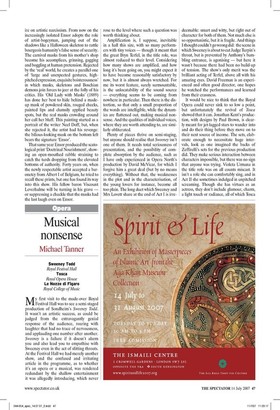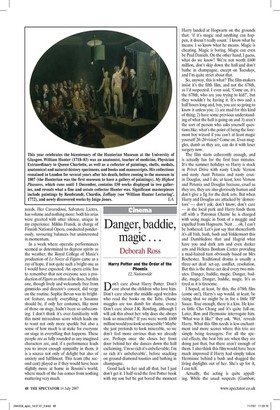Musical nonsense
Michael Tanner Sweeney Todd Royal Festival Hall Tosca Royal Opera House Le Nozze di Figaro Royal College of Music My first visit to the made-over Royal Festival Hall was to see a semi-staged production of Sondheim's Sweeney Todd. It wasn't an artistic success, as could be judged from the extravagantly genial response of the audience, roaring with laughter that had no trace of nervousness, and applauding one number after another. Sweeney is a failure if it doesn't alarm you and also lead you to empathise with Sweeney even in the act of slitting throats. At the Festival Hall we had merely another show, and the confused and irritating article in the programme, as to whether it's an opera or a musical, was rendered redundant by the shallow entertainment it was allegedly introducing, which never rose to the level where such a question was worth thinking about.
Amplification is, I suppose, inevitable in a hall this size, with so many performers with tiny voices — though it meant that the great Bryn Terfel, in the title role, was almost reduced to their level. Considering how many shows are amplified, and how long it's been going on, you might expect it to have become reasonably satisfactory by now, but it is almost always wretched. For me its worst feature, surely surmountable, is the unlocatability of the sound source — everything seems to be coming from nowhere in particular. Then there is the distortion, so that only a small proportion of the words are intelligible, while the dynamics are flattened out, making musical nonsense. And the qualities of individual voices, where they are worth attending to, are similarly obliterated.
Plenty of pieces thrive on semi-staging, but anyone should realise that Sweeney isn't one of them. It needs total seriousness of presentation, and the possibility of complete absorption by the audience, such as I have only experienced in Opera North's production by David McVicar, for which I forgive him a great deal (but by no means everything). Without that, the weaknesses in the plot and in the characterisation, of the young lovers for instance, become all too plain. The long duet which Sweeney and Mrs Lovett share at the end of Act I is irredeemable: smart and witty, but right out of character for both of them. Not much else is so opportunistic, but it is fragile. And things I thought couldn't go wrong did: the scene in which Sweeney is about to cut Judge Turpin's throat, but is prevented by Anthony's bumbling entrance, is agonising — but here it wasn't because there had been no build-up of tension. The show's only merit was the brilliant acting of Terfel, above all with his amazing eyes. David Freeman is an experienced and often good director, one hopes he watched the performances and learned from their crassness.
It would be nice to think that the Royal Opera could never sink to so low a point, but unfortunately the revival of Tosca showed that it can. Jonathan Kent's production, with designs by Paul Brown, is clearly meant for jet-lagged stars to wander into and do their thing before they move on to their next source of income. The sets, elaborate enough to necessitate huge intervals, look as one imagined the backs of Zeffirelli's sets for the previous production did. They make serious interaction between characters impossible, but there was no sign that anyone was trying. Violeta Urmana in the title role was on all counts miscast. It isn't a role she can comfortably sing, and in Act II she sometimes indulged in unpitched screaming. Though she has virtues as an actress, they don't include glamour, charm, a light touch or radiance, all of which Tosca needs. Her Cavaradossi, Salvatore Licitra, has volume and nothing more: both his arias were greeted with utter silence, unique in my experience. Mikko Franck, in charge of Finnish National Opera, conducted ponderously, savouring balances but uninterested in momentum.
In a week where operatic performances seemed as determined to depress spirits as the weather, the Royal College of Music's production of Le Nozze di Figaro came as a ray of hope, if not quite such a bright one as I would have expected. An opera critic has to remember that not everyone sees a production ofFigaro as often as he does, but this one, though lively and welcomely free from gimmicks and director's conceit, did verge on the routine. Sophie Bevan was its brightest feature, nearly everything a Susanna should be, if only her costumes, like most of those on stage, hadn't been so unbecoming. I don't think it's over-familiarity with this most miraculous score which leads me to want not only more sparkle but also a sense of how much is at stake for everyone on stage in everything that happens. These people are as fully rounded as any imagined characters are, and, if a performance leads you to invest enough sympathy in them, it is a source not only of delight but also of anxiety and fulfilment. This team (the second cast) played as if they would have been slightly more at home in Rossini's world, where much of the fun comes from nothing mattering very much.


















































 Previous page
Previous page